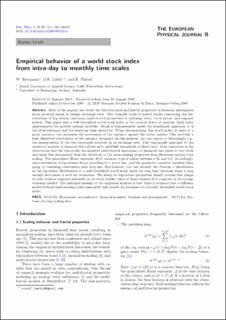Please use this identifier to cite or link to this item:
https://doi.org/10.21256/zhaw-4211| Publication type: | Article in scientific journal |
| Type of review: | Peer review (publication) |
| Title: | Empirical behavior of a world stock index from intra-day to monthly time scales |
| Authors: | Breymann, Wolfgang Lüthi, David Platen, Eckhard |
| DOI: | 10.21256/zhaw-4211 10.1140/epjb/e2009-00341-x |
| Published in: | The European Physical Journal B |
| Volume(Issue): | 71 |
| Page(s): | 511 |
| Pages to: | 522 |
| Issue Date: | 2009 |
| Publisher / Ed. Institution: | Springer |
| ISSN: | 1434-6028 1434-6036 |
| Language: | English |
| Subjects: | Financial markets; Economics; Systems obeying scaling laws; Business and management |
| Subject (DDC): | 332: Financial economics |
| Abstract: | Most of the papers that study the distributional and fractal properties of financial instruments focus on stock prices or foreign exchange rates. This typically leads to mixed results concerning the distributions of log-returns and some multi-fractal properties of exchange rates, stock prices, and regional indices. This paper uses a well diversified world stock index as the central object of analysis. Such index approximates the growth optimal portfolio, which is demonstrated under the benchmark approach, it is the ideal reference unit for studying basic securities. When denominating this world index in units of a given currency, one measures the movements of the currency against the entire market. This provides a least disturbed observation of the currency dynamics. In this manner, one can expect to disentangle, e.g., the superposition of the two currencies involved in an exchange rate. This benchmark approach to the empirical analysis of financial data allows us to establish remarkable stylized facts. Most important is the observation that the repeatedly documented multi-fractal appearance of financial time series is very weak and much less pronounced than the deviation of the mono-scaling properties from Brownian-motion type scaling. The generalized Hurst exponent H(2) assumes typical values between 0.55 and 0.6. Accordingly, autocorrelations of log-returns decay according to a power law, and the quadratic variation vanishes when going to vanishing observation time step size. Furthermore, one can identify the Student t distribution as the log-return distribution of a well-diversified world stock index for long time horizons when a long enough data series is used for estimation. The study of dependence properties, finally, reveals that jumps at daily horizon originate primarily in the stock market while at 5min horizon they originate in the foreign exchange market. The principal message of the empirical analysis is that there is evidence that a diffusion model without multi-scaling could reasonably well model the dynamics of a broadly diversified world stock index. |
| Further description: | Erworben im Rahmen der Schweizer Nationallizenzen (http://www.nationallizenzen.ch) |
| URI: | https://digitalcollection.zhaw.ch/handle/11475/4664 |
| Fulltext version: | Published version |
| License (according to publishing contract): | Licence according to publishing contract |
| Departement: | School of Engineering |
| Organisational Unit: | Institute of Data Analysis and Process Design (IDP) |
| Appears in collections: | Publikationen School of Engineering |
Files in This Item:
| File | Description | Size | Format | |
|---|---|---|---|---|
| 2009_Breymann_Empirical behavior of a world stock index_European Physical Journal B.pdf | 1.02 MB | Adobe PDF |  View/Open |
Show full item record
Breymann, W., Lüthi, D., & Platen, E. (2009). Empirical behavior of a world stock index from intra-day to monthly time scales. The European Physical Journal B, 71, 511–522. https://doi.org/10.21256/zhaw-4211
Breymann, W., Lüthi, D. and Platen, E. (2009) ‘Empirical behavior of a world stock index from intra-day to monthly time scales’, The European Physical Journal B, 71, pp. 511–522. Available at: https://doi.org/10.21256/zhaw-4211.
W. Breymann, D. Lüthi, and E. Platen, “Empirical behavior of a world stock index from intra-day to monthly time scales,” The European Physical Journal B, vol. 71, pp. 511–522, 2009, doi: 10.21256/zhaw-4211.
BREYMANN, Wolfgang, David LÜTHI und Eckhard PLATEN, 2009. Empirical behavior of a world stock index from intra-day to monthly time scales. The European Physical Journal B. 2009. Bd. 71, S. 511–522. DOI 10.21256/zhaw-4211
Breymann, Wolfgang, David Lüthi, and Eckhard Platen. 2009. “Empirical Behavior of a World Stock Index from Intra-Day to Monthly Time Scales.” The European Physical Journal B 71: 511–22. https://doi.org/10.21256/zhaw-4211.
Breymann, Wolfgang, et al. “Empirical Behavior of a World Stock Index from Intra-Day to Monthly Time Scales.” The European Physical Journal B, vol. 71, 2009, pp. 511–22, https://doi.org/10.21256/zhaw-4211.
Items in DSpace are protected by copyright, with all rights reserved, unless otherwise indicated.